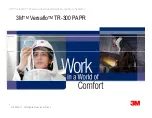
Notice!
This instruction manual describes the proper use of the product
and serves to prevent hazards. It must be read and followed.
The warranties made by MSA AUER with respect to the product
are voided if the product is not used and serviced in accordance
with the instructions in this manual.
Choice and use of filtering devices are beyond the control
of MSA AUER but are the responsibility of the user. Therefore,
the liability of MSA AUER covers only the consistent quality of
this product.
The above does not alter statements regarding the warranties
and conditions of sale and deliveries.
Instructions for Use
1
Designation, Marking and Application
1.1
Designation
Full Face Mask MSA AUER Ultra Elite PS
1.2
Marking
AUER Ultra Elite on faceblank, PS on cover
1.3
Application
The Full Face Mask is not a complete respiratory protective
device by itself, but serves as facepiece (EN 136, class 3) with
plug-in connector for use with positive pressure (pressure
demand) compressed air breathing apparatus and can only be
used with the corresponding MSA AUER CBA BD 88 AS. The rel-
evant instructions for use of these apparatus and applicable
national standards and regulations must be observed. The mask
is only used for two-way breathing. For use in areas subject to
explosion hazard, treat mask with anti-static spray or use water
mist. Users with facial hair like beards or sideburns are not like-
ly to achieve a tight seal since the hair will break the facepiece-
to-face seal. In order to achieve a tight fit for people requiring
prescription eyewear, the Ultra Elite spectacle kit must be used.
The full face mask Ultra Elite PS is in accordance with currently
valid performance requirements (89/686/EEC) and approval
regulations.
2
Design, Operation and Use of Full Face Mask
Design according to Fig. 1. The inhalation air flows from the
connector of the mask past the inhalation valve to the inside of
the lens (thus keeping the lens largely fogfree) and then
through the check valves into the nose cup. The exhalation air
passes through the exhalation valve directly to the ambient
atmosphere.
2.1
Readiness
The mask is kept ready for use either suspended by the carrying
strap in front of the chest or inside the carrier. When the mask is
suspended in front of the chest, the hook of the carrying strap is
fastened to the forehead buckle in order to protect the mask
from dirt.
2.2
Donning
Spread the head harness with both hands and place chin into
chin stop. Pull harness over head (make sure that straps lie flat
against head) and tighten straps evenly and firmly, starting with
neck straps, then temple straps and finally the forehead strap
(Fig. 2 and 3).
2.3
Leak Test
In order to check the facepiece-to-face seal, a leak test must be
performed. To do this, cover the connector opening or the air
intake of the filter with the palm of the hand (Fig. 4). When
inhaling and holding the breath no air shall leak in. The mask
must pass the leak test before each use. A more reliable leak
test is with the complete respirator in a suitable test chamber.
2.4
Removal
To loosen the head harness, push the buckles forward (Fig. 5).
Then grasp the mask by the connector and pull it backwards
over the head (Fig. 6).
3
Maintenance
Notice!
After each cleaning, disinfection and maintenance a leak test
must be done.
3.1
Cleaning
The dirty mask is cleaned with lukewarm water containing a
mild detergent. Prior to washing, remove inhalation and exhala-
tion valve discs, unbutton the nose cup and unscrew the speak-
ing diaphragm. These components are cleaned separately and
reassembled only after drying. Cleaned parts must not be dried
in radiant heat (sunlight, radiators). When using a drying cabi-
net the temperature must not exceed 50 °C (see table 5 for
cleaning intervals).
3.2
Disinfection
Masks should be disinfected after having been cleaned as
described above. The Disinfectant AUER 90 or MSA Cleaner
Sanitizer is recommended. Information about the concentration
and time is contained in the Instructions for Use of disinfectant.
After disinfecting thoroughly flush all components with water,
dry and reassemble (see table 5 for disinfection intervals).
3.3
Maintenance of the Full Face Mask
Maintenance includes testing the functioning and tightness of
the mask, as well as replacing components.
In case of a leak, establish a positive pressure inside the mask
and localize the leak by submerging the mask into water and
observing the rising bubbles. This part of the mask has to be
changed.
Only MSA AUER spare parts must be used for repair.
3.3.1 Replacing the Exhalation Valve Disc
In case of a leak at the exhalation valve disc, open the bottom
cover/door, carefully, remove the spring retainer complete with
spring and pull off valve disc complete with guide pin. Replace
valve disc with pin and snap in spring retainer with spring again.
3.3.2 Replacing the Connector
In case of a leak at the connector, replace the entire connector.
To do this, unbutton the nose cup, remove the clamp and unbut-
ton the connector from the faceblank. The inhalation valve seat,
the inhalation valve disc, the speech diaphragm and the
diaphragm ring are removed and can be reused (see table 5 for
replacing intervals). Replacing the parts, first button the nose
cup to the connector and afterwards both to the faceblank.
3.3.3 Replacing the Speech Diaphragm
Replacing the speech diaphragm unbutton the nose cup and
unscrew the diaphragm ring. Assemble the new speaking
4
Summary of Contents for Ultra Elite PS
Page 21: ...21 Abb 2 Abb 3 Abb 4 Abb 5 Abb 6...






























